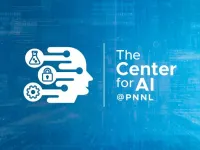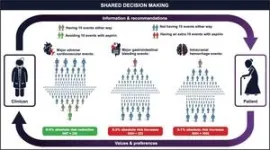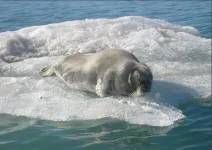(Press-News.org) RICHLAND, Wash.—The Department of Energy’s Pacific Northwest National Laboratory has created the Center for AI @PNNL to coordinate the pioneering research of hundreds of scientists working on a range of projects focused on science, security and energy resilience.
Researchers at PNNL were among the first to dive into artificial intelligence decades ago. But AI has surged in the past year with the ready availability of generative AI, which allows almost anyone to produce sophisticated—though sometimes errant—text and images with just a small amount of data. At the same time, AI is a vital tool for serious researchers as well as a subject all its own for scientists to create, explore and validate new ideas. AI also presents an exciting opportunity for PNNL scientists to advance a critical area of science and chart the path forward.
“PNNL has deep expertise and decades of experience in computing and artificial intelligence that we apply to advance scientific discovery, strengthen energy resiliency and enhance national security,” said Steven Ashby, Laboratory Director. “The creation of the Center for AI @PNNL will leverage and amplify these capabilities for even greater impact in service of our nation.”
The announcement from PNNL comes the same week as AI experts from around the world are gathering at the annual Conference on Neural Information Processing Systems, known as NeurIPS, Dec. 10-16 in New Orleans. PNNL researchers are making more than a dozen presentations at the highly selective meeting, a demonstration of PNNL’s expertise in AI.
“The time is right for PNNL to focus its AI-related efforts,” said Court Corley, the Laboratory’s chief scientist for AI and director of the new center. “The field is moving at light speed, and we need to move quickly to keep PNNL at the frontier.”
A priority of the Center for AI @PNNL is developing ways to keep AI secure and trustworthy, in support of President Biden’s recent executive order calling for the development of safe, secure and trustworthy AI. PNNL scientists have already contributed to the IEEE Ethics Certification Program for Autonomous and Intelligent Systems, a program to make sure algorithms are trustworthy and free of bias.
As a DOE Office of Science laboratory, the primary focus of AI at PNNL is on challenges related to science. One team is using AI to develop ways to predict which hurricanes are most likely to strengthen rapidly and unexpectedly. Another team is focused on the world of microbes, whose actions can be harnessed to produce important chemicals faster and less expensively than is possible today.
Many of the applications of AI research at PNNL are focused on energy resilience and on keeping the world secure. Laboratory scientists use AI to improve the operation of the nation’s electrical grid, keeping power flowing to homes and businesses. Others are using machine learning to explore new combinations of compounds that could power the next generation of lithium batteries. Another common application is protection against the proliferation of nuclear materials.
Most recently, PNNL’s AI capabilities have been used to help firefighters predict the paths of wildfires.
PNNL scientists don’t simply use existing artificial intelligence techniques to tackle such challenges. Its researchers are transforming the fundamentals of AI—improving or creating programs for researchers around the world. One example is the impact that PNNL has had in an area known as “few-shot learning.” When there are just a few examples for an AI program to learn from, PNNL has developed ways to use that scant data to make reliable recommendations. Laboratory researchers have also pioneered the concept of physics-informed machine learning and machine reasoning, encoding physics knowledge into AI networks to improve their accuracy for a broad set of scientific questions.
PNNL’s work in AI is enhanced by its long history of data analysis and access to large amounts of data. For example, a materials chemistry experiment might rely on processing thousands of microscope images per second, and a hunt for biomarkers for diseases like cancer will rely on millions of sensitive measurements of the body’s proteins and other molecules. PNNL researchers are experts at generating, managing and analyzing such data—and at understanding how AI can best be deployed in such situations.
Among the other areas of interest to the participants of the Center for AI @PNNL: the creation and development of an AI-ready workforce; the deployment of AI in daily operations at PNNL; exploration of how humans and AI programs can best work together; and autonomous experimentation, where AI can direct robots’ activity in the laboratory, analyze results, then map out and even direct subsequent tasks.
Much of PNNL’s work in AI and computing is done with a broad group of partners, including North Carolina State University, University of Washington, Washington State University, Microsoft, Micron, University of Texas at El Paso, Georgia Institute of Technology, Western Washington University, and other national laboratories and organizations.
PNNL works closely with DOE’s Office of Science Advanced Scientific Computing Research program, which has invested in PNNL’s leadership of the advanced memory research and development project to support AI for science. Scientists at the Center for AI @PNNL will also work closely with DOE’s newly launched Office of Critical and Emerging Technology for the development of a national AI capability to develop safe, secure and trustworthy AI.
“AI is such an integral part of the landscape at PNNL that’s it’s difficult to find an area that AI hasn’t touched,” said Corley. “With so much happening, it’s crucial to make collaboration easier and for people to come together to develop a Lab-wide strategy to optimize everyone’s efforts.”
# # #
END
USD$200,000 awarded to tackle today’s pressing consumer technology demands
Utilizing smart optical sensors for IoT
Providing more realistic virtual and augmented realities
WASHINGTON – The Optica Foundation today released more detailed information on information technology research funded by the 2023 Optica Foundation Challenge. Researchers Zaijun Chen, University of Southern California, USA, and Alejandro Velez-Zea, Universidad de Antioquia, Colombia, both proposed novel approaches to addressing the flow of data and information in consumer-centric technologies.
“The ...
Certain facial features—like downturned lips and a heavy brow—are known to make someone appear untrustworthy to others, even though these do not indicate a person’s actual character. Such facial biases influence our everyday social interactions as well as high-stakes decisions, including who we hire, or elect to political office.
But a new study by Columbia researchers shows that the effects of these judgments can be mitigated. The study outlines the results of four experiments that the authors conducted with 1,400 volunteers. Through those experiments, the researchers found that when real-world defendants have facial features that appear untrustworthy, they are more likely ...
Photolithography involves manipulating light to precisely etch features onto a surface, and is commonly used to fabricate computer chips and optical devices like lenses. But tiny deviations during the manufacturing process often cause these devices to fall short of their designers’ intentions.
To help close this design-to-manufacturing gap, researchers from MIT and the Chinese University of Hong Kong used machine learning to build a digital simulator that mimics a specific photolithography manufacturing process. Their technique utilizes real data gathered from the photolithography system, so it can more ...
Arctic seals have evolved many adaptations to cope with their frosty environment—one that you might not immediately think of is the bones in their nasal cavity. Arctic seals have more convoluted nasal passages than seal species that live in milder environments, and researchers report December 14 in the Biophysical Journal that these structures help the seals more efficiently retain heat and moisture as they breathe in and out.
“Thanks to this elaborate structure in their nasal cavities, Arctic seals lose less heat through nasal heat exchange than subtropical seals when both are exposed to the same ...
Aging poses a number of challenges to the body’s well-being, one of the most important being an increased susceptibility to multiple diseases, including urinary tract infections (UTIs). The connection between aging and more prevalent UTIs is not well understood, but now researchers at Baylor College of Medicine have found an explanation.
The researchers show in the journal Developmental Cell that, compared to the younger counterpart, the aging urinary tract in animal models changes how it functions at the cellular level in ways that seem to favor the establishment ...
People who live in neighborhoods with higher levels of poverty and unemployment are less likely to fill their heart-failure drug prescriptions than those living in wealthier areas, a new study shows. The findings not only add to understanding geographic and economic disparities in heart disease care, but also point to new ways to address barriers for patients taking these lifesaving drugs.
Led by researchers at NYU Grossman School of Medicine, the study explored prescription pickup patterns among patients with systolic heart failure, a chronic, life-threatening ...
Cats tend to dictate games of fetch with their owners and most cats who play fetch learned to do so without explicit training, according to a survey of 924 cat owners published in Scientific Reports. The findings also highlight the variety of objects that cats prefer to fetch, including hair ties and bottle parts.
Jemma Forman, Elizabeth Renner and David Leavens surveyed cat owners who reported fetching behaviours in 1,154 cats that they currently or previously owned. Owners reported how fetching first occurred, how often it occurs ...
A multidisciplinary study published in Nature has elucidated the structure of the machinery responsible for writing much of our “dark genome” — the 98 percent of our DNA that has largely unknown biological function. These results may spur entirely novel treatments for autoimmune diseases, cancer and neurodegeneration.
An international team of scientists from Rutgers and more than a dozen other institutions, including both academia and industry, have published the first high-resolution images and structural details of avirus-like element known as LINE-1. They describe it as “an ancient genetic parasite” that is one of the most common parts of human DNA (video ...
About The Study: In this study of 6,247 patients with heart failure with reduced ejection fraction, patients living in neighborhoods with lower neighborhood-level socioeconomic status had significantly higher odds of nonadherence to guideline-directed medical therapy. These findings highlight the importance of considering neighborhood-level disparities when developing approaches to improve medication adherence.
Authors: Amrita Mukhopadhyay, M.D., of the NYU Grossman School of Medicine in New York, is the corresponding ...
About The Study: The natural history of sleep disturbances was associated with both resolved and incident emotional and behavioral difficulties in this study of 17,000 preschool-aged children. Routine screening and precise intervention for sleep disturbances may benefit the psychosocial well-being of this population.
Authors: Fan Jiang, M.D., Ph.D., and Guanghai Wang, Ph.D., of Shanghai Jiao Tong University in Shanghai, are the corresponding authors.
To access the embargoed study: Visit our For The Media ...



